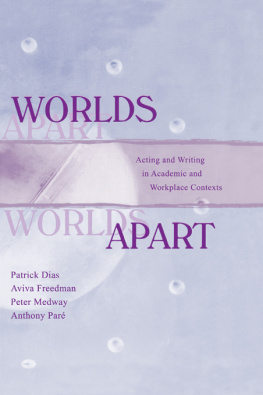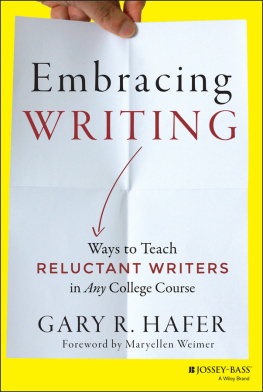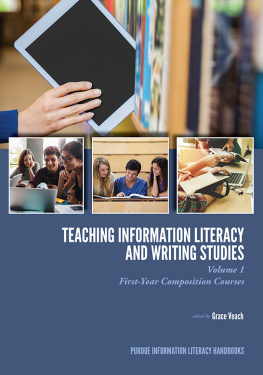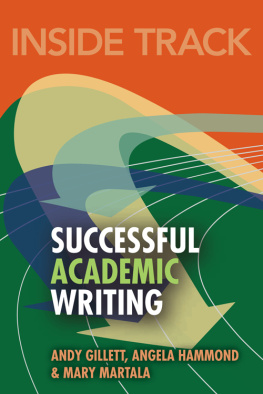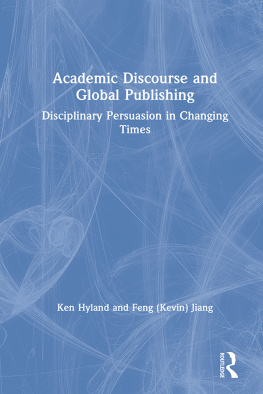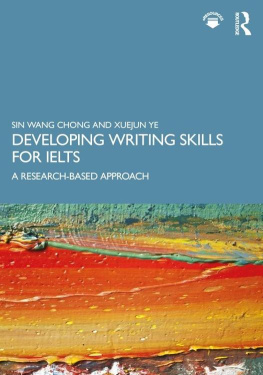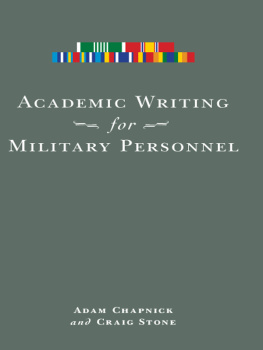

WORLDS APART
Acting and Writing in Academic and Workplace Contexts
RHETORIC, KNOWLEDGE, AND SOCIETY
A Series of Monographs Edited by Charles Bazerman
Winsor Writing Like an Engineer: A Rhetorical Education
Van Nostrand Fundable Knowledge: The Marketing of Defense Technology
Petraglia Reality by Design: The Rhetoric and Technology of Authenticity in Education
Prior Writing/Disciplinarity: A Sociohistoric Account of Literate Activity in the Academy
Swales Other Floors, Other Voices: A Textography of a Small University Building
Atkinson Scientific Discourse in Sociohistorical Context: The Philosophical Transactions of the Royal Society of London, 16751975

WORLDS APART
Acting and Writing in Academic and Workplace Contexts
Patrick Dias
Aviva Freedman
Peter Medway
Anthony Par

First Published by
Lawrence Erlbaum Associates, Inc., Publishers
10 Industrial Avenue
Mahwah, NJ 07430
Transferred to Digital Printing 2011 by Routledge
711 Third Avenue, New York, NY 10017
2 Park Square, Milton Park, Abingdon, Oxon, OX14 4RN
Copyright 1999 by Lawrence Erlbaum Associates, Inc.
All rights reserved. No part of this book may be reproduced in any form, by photostat, microfilm, retrieval system, or any other means, without prior written permission of the publisher.
Cover design by Kathryn Houghtaling Lacey
Library of Congress Cataloging-in-Publication Data
Worlds Apart: acting and writing in academic and workplace
contexts / Patrick Dias [et al.].
p. cm.
Includes bibliographical references and index.
ISBN 0-8058-2147-3 (cloth : alk. paper)
ISBN 0-8058-2148-1 (pbk. : alk. paper)
English languageRhetoricStudy and teaching. 2. Academic writingStudy and teaching. 3. Technical writingStudy and teaching. 4. Business writingstudy and teaching. I. Dias, Patrick.
PE1404.W665 1999
808dc21
9849931
CIP
Publishers Note
The publisher has gone to great lengths to ensure the quality of this reprint but points out that some imperfections in the original may be apparent.

CONTENTS

EDITORS INTRODUCTION
Charles Bazerman
University of California, Santa Barbara
Worlds Apart: Acting and Writing in Academic and Workplace Contexts is an impressive multisite comparative study of writing in different university courses and matched workplaces: law and public administration courses and government institutions; management courses and financial institutions; social work courses and social work agencies; and architecture courses and architecture practice. The study, carried out across 7 years by a dozen people, looked intently into how writing functions within the activities of each of these various settings. The study, despite its size and multi-authorship, avoids the simplifications that typically are needed to generate consistency and comparability across extensive data. Rather than looking for easy points of comparison, the authors sought to understand each setting through detailed ethnography and found comparisons only by understanding how writing is operative within the particularities of settings.
This revealing theoretical understanding was developed in a conversation among the four lead investigators over the years of the project, a conversation that I saw as a distant onlooker and then as an editor. Although there are numerous other products of this research project, this book is a culmination of that theoretical discussion about the overall meanings of all of the findings. What they found at each of the sites was that learning to write in the locally relevant genres was a means by which individuals were socialized into the particular activities, ideologies, identities, meaning systems, power structures, institutional goals, and cooperative endeavors enacted in each place. Furthermore, those genres became the site of tension among the various motives, perceptions, and goals of different individuals as those in institutional power tried to regulate others into particular ways of life, and others insisted that important motives were being lost if they wrote as they were directed, as in the case of the social work agency. Yet, in many of the sites the generic shaping of the communal activity and way of life went uncontested as individuals wanted to become creative architects, competent lawyers, recipients of contracts, contributors to a well-analyzed monetary policy, or just students with good grades.
Each of these settings offered different pathways of explicit and implicit instruction, mentoring, disciplining, accountability, and evaluation. In schools, no matter what the subject area, the socialization into practice predictably appeared as pedagogy directed toward student performance of known practice, for which students were held accountablewhat the authors here have called facilitated performance. Although workplace internship experiences carried important elements of learning, these still became framed as facilitated performance when returned to the classroom. In the workplace, the focus was on the work task at hand, rather than the overt instruction and evaluation of the learner; the learning was in the doing and the accountability was in the accomplishment of the work; insofar as there was overt training, it was built around the learners actual participation in the work, either through what the authors call attenuated authentic performance (where mentors limit, focus, advise, and themselves remain responsible for the tasks of the novices) or through legitimate peripheral participation (Lave and Wegners term here used to indicate the novices actual responsibility and accountability for limited tasks performed).
In each of the classroom and workplace sites, the writing was integrated with relevant practices, modes of expression, and material realities, but most of the classrooms were so fully devoted to textual practices that the world of student production was tightly framed by the written and spoken texts that made up the course. The most notable exception was in architecture, where the writing was integrated with, and subordinated to, visual and material design; internship courses also provided some contact with the social, material, and representational complexity of the workplace, although students papers remained the central form of evaluation and responsibility. In the workplace, however, the writing was integrated with many forms of experience and representation in the course of the workrelationship with and responsibility toward clients and the dramatic realities of courtroom proceedings; economic data and the actual economic well-being of a nation; and, again most strikingly, in architecture, the visual design and material construction. These issues are made most explicit in the chapters on architectural education and practice, but they are an undercurrent throughout the book.
Next page
